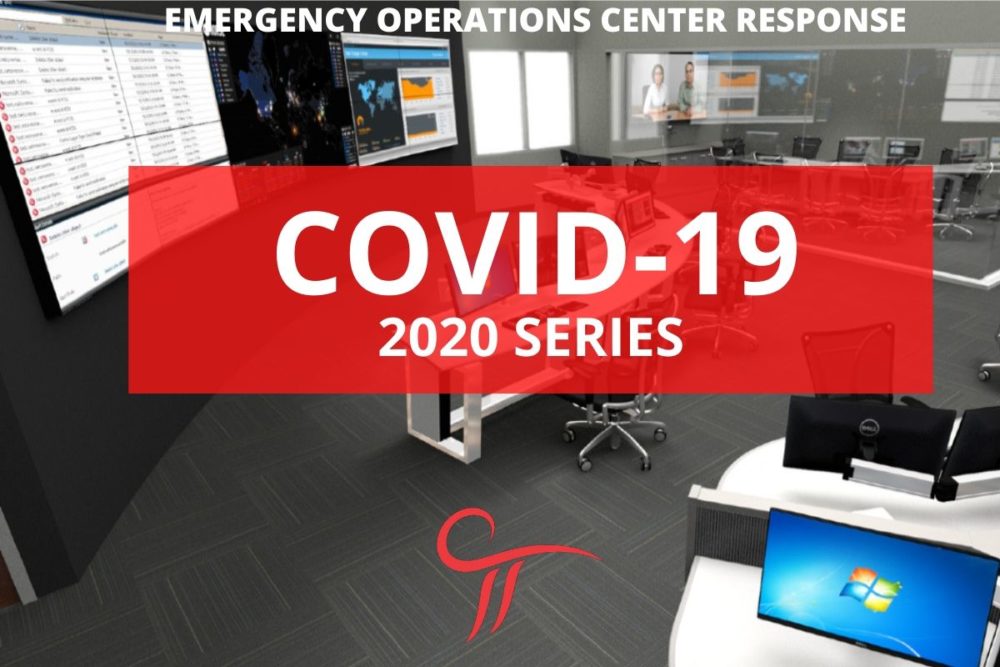Now that the coronavirus’ spread has officially been reached the level of a pandemic, emergency operations centers have been activated at the city and state level all over the country. These local EOCs play a pivotal role in response and containment.
An emergency operations center serves as a central point of contact for any local parties. Having a unified operations center at the local level also ensures that public health activities and data are collected, tracked and reported in a consistent manner.
The EOC ensures that up-to-date information can be shared among federal, state and local partners as well as with the public.
How Emergency Operations Centers Function
When there is a public health threat, applying emergency management best practices including the activation of emergency operations centers can help local public health systems to protect the population.
An EOC serves as the opportunity for multiple departments and partners to collaborate on common goals and strategies. Unifying the effort to protect public health provides efficient response and prevents local infrastructure from becoming overwhelmed.
For many localities, the day-to-day activities and resources are not enough for an emergency response to a public health crisis. Decisions must be made quickly, sometimes with ambiguous information, and response times necessarily must be shorter.
Emergency operations centers are triggered when there is a need for significant coordination with external partners, when multiple agency programs are involved, and/or when there is high political or media interest.
How EOCs Are Responding to COVID-19
In Madison, Wisc., the State Emergency Operations Center (SEOC) has elevated to a Level 1 response, which means it now houses all state agencies together so they can better coordinate COVID-19 response. [related]
Elevating to Level 1, the highest level or response available, ensures that the emergency operations center is as best equipped as it can be to assist the public during a health crisis.
Emergency operations centers are also key in distributing important information during times of public crisis. The Emergency Operations Center in Worcester, Mass., has daily briefings where the City Council, School Committee, superintendent and other key operators receive any updates on the situation to continue with the best-informed response.
Because COVID-19 is a rapidly developing situation, consistent and continued updates are vital to effective emergency operations.
During a public health crisis, emergency operations centers are critical for coordinating response and for disseminating information to the public. Activations and level elevations are occurring in EOCs across the country to better serve their local constituents.
Declaring a state of emergency and activating emergency operation centers allows for expedited processes and greater resources to deal with public health emergencies. It also enables increased staffing to assist with emergency operations.
Emergency Operations Center Design
A successful operation is the result of quality data and the persistence of the emergency operations team. Operations center design should help, not hinder, operations to allow for quick and efficient coordination and response.
Since an EOC serves as the central hub of incident preparation and response, emergency operators must be able to gather and share critical information, coordinate response initiatives, and manage personnel across various departments.
Emergency operations center design should not distract from the vital roles that need to be performed; rather it should make those roles easier to perform.
Public safety in the event of a major health event can depend on an EOC running at peak efficiency. Staff in the emergency operations center must be able to display a variety of data on the 24/7 video wall so that information can quickly be aggregated, analyzed, and shared.
Because emergency operations centers’ tasks are critical, it is important to work with an AV integrator that can recommend the most reliable products so your technology weathers through the toughest conditions.
The emergency operations center furniture solutions used in your EOC installation can also contribute to efficiency. Space design and furniture arrangements should enable coordination between operators and allow a clear view to the video wall for everyone in the room.
Additionally, the shifts during an emergency can be long and grueling. Furniture and video wall positions should be decided with ergonomics in mind so that operators can work without the added distraction of avoidable discomfort.
Moments of panic and crisis often remind us how invaluable the multiple types of operations centers involved in emergency response can be. It’s important that emergency operations centers, medical command centers, and social media monitoring centers be up-to-date in order to provide efficient, reliable response.
If your mission critical environment hasn’t been updated in several years, the technology may not be as reliable as it should be for round-the-clock use in a crisis situation.










